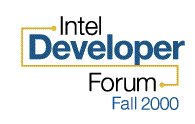 Intel's Developer Forum, known to the rest of the computer loving world as
IDF, kicked off today with some interesting news and demonstrations. Let's take
a look at what AnandTech saw.
Intel's Developer Forum, known to the rest of the computer loving world as
IDF, kicked off today with some interesting news and demonstrations. Let's take
a look at what AnandTech saw.
The Keynote
The event officially started at 8:00am with a keynote address given jointly by Intel CEO Craig Barrett and Albert Yu, senior vice president and general manager of the Intel Architecture Group. Beginning with an introduction by Craig Barrett, the keynote quickly jumped into the importance the processor in internet business and layout, a theme that was duplicated throughout the day.
Throwing out catch phrases such as "modular Internet" and "e-Business", Barrett was quick to catch the attention of the OEM and large business companies while almost completely losing the consumer interest. It was not until Albert Yu came on stage around 9:00am PST was the real interesting stuff demonstrated and spoken about.
 |
|
Mr.
Albert Yu
|
Maintaining the flow brought about by Barrett's speech, Yu quickly moved into demonstrating just what Intel has in mind for e-business servers. The demonstration included the running of a live e-commerce application (actually nothing more than an mp3 streaming server) on clustered Itanium servers, with no data interruption when the power to one of the servers was cut on cue. Yu announced that Intel has been shipping 6,000 prototype Itanium systems and has already made 350 common business applications ready to port to the new IA-64 instruction set. If you recall from our x86-64 review last week, implementing 64-bit applications on the now delayed Itanium processor will take more than just a bit of time and is most likely part of the motivation for pushing the Itanium shipping date back from Q4 of 2000 to Q1 of 2001. Soon after the Itanium demonstration, Yu announced that 1GHz Xeon parts running on a 133MHz bus with 256KB of L2 cache were now shipping as of today. Whether these parts will be available or not has yet to be seen. Also, we have yet to see an available server platform to use with these 133MHz FSB Xeons that doesn't use RDRAM.
Yu next went to discuss the Pentium III mobile processor, making the transition from large scale servers to small notebooks. While the talk did consist of some discussion about the Pentium III's speed step technology, which allows for different CPU clock speeds and voltages when the laptop is plugged in and when it is on battery, the majority of the talk about the mobile parts seemed to be more of a competitor bash than a product description. The mobile section of Yu's talk was mostly focused on stressing how small the amount of power the CPU consumes is in comparison to the system as a whole. It seemed that Yu was mostly concerned with downplaying the issue of low power consuming laptops by showing that other system components quickly eat up much more power than the CPU itself. This may or may not be true, depending on how Intel got it's CPU power consumption, which they claimed to be as low as .85 watts when running a standard application. We know that the peak power consumption of all mobile Pentium systems is greater than this low number, suggesting that Intel is quoting power usage amounts when the CPU is essentially "asleep", like when typing in an office document. Only the release of the Transmeta processor, as well as other low voltage CPUs will tell if Intel is right about CPU power, preaching that the power of other system components (the graphics processor, for example) must be decreased before any extension of battery life is observed.
Finally, Yu went on to talk about the already announced Pentium 4 and its Net Burst technology, as we discussed in our Monday review of Net Burst. Most of what Yu described was already covered in detail in this article, but we did get to see two Pentium 4 systems in action. The first demonstration involved a 1.4GHz Pentium 4 system with 400MHz (PC800) RDRAM and involved running a "photo-realistic 3D application." Although this sounds impressive, all it proved to be was an application that looked nearly identical to the pond demo that shipped with the original GeForce256, even having the same NVIDIA logo on the bottom. Yu and the Intel employee demonstrating the product proclaimed that only the power the the Pentium 4 could produce such photo-realisitc effects. We beg to differ, as even our old Pentium 550E had no trouble running the original pond demo that shipped with the GeForce256.Along with the "power" of the Pentium 4 that was displayed with the "photo-realistic 3D application," Yu demonstrated on the fly DV to MPEG2 video decoding. This, unlike the pond demo, would prove to be rather stressful for a processor at lower speeds and without SSE2, as the demonstration proved. Running the encoding and decoding process on a Pentium III 800 proved to be a challenging task, dropping 408 frames out of the 938 sent to it. The Pentium 4 system, on the other hand, had no problem performing these highly complex calculations, capturing 938 out of 938 frames.
The final part of Yu's demonstration included showing an air-cooled Pentium 4 system running at 2.0GHz. Impressive in itself, as it proved that Moore's law still applied (it was exactly 18 months ago that Intel demoed a 1GHz system), the system was only running CPUID and nothing else. Much like the 1.5GHz Pentium 4 system demoed at last spring's IDF, it is most likely that only CPUID was run due to the fact that stressing the system with other applications would result in system instability.










0 Comments
View All Comments